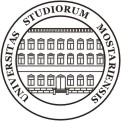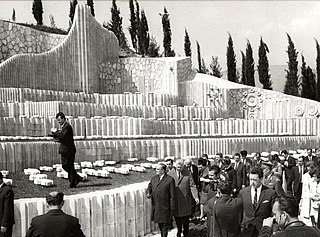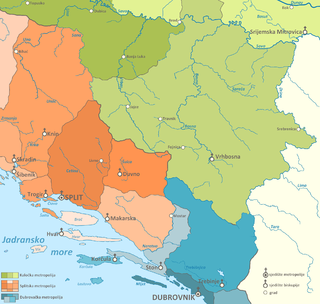
The Herzegovina-Neretva Canton is one of 10 cantons of the Federation of Bosnia and Herzegovina in Bosnia and Herzegovina.

Mostar is a city and the administrative center of Herzegovina-Neretva Canton of the Federation of Bosnia and Herzegovina, an entity of Bosnia and Herzegovina.

The University of Mostar is the largest public university located in Mostar, Bosnia and Herzegovina.

Mostar International Airport is an airport near Mostar, Bosnia and Herzegovina, situated in the village of Ortiješ, 4 NM southeast of Mostar's railway station.

Tourism in Bosnia and Herzegovina is a fast-growing sector making up an important part in the economy of the country.

The Žitomislić Monastery is а Serbian Orthodox monastery dedicated to the Annunciation and located near Mostar, Bosnia and Herzegovina.

Počitelj is historic village and an open-air museum in Bosnia and Herzegovina. It is located in the municipality of Čapljina, in the Herzegovina-Neretva Canton of the Federation of Bosnia and Herzegovina. The historic village is situated on the left bank of the river Neretva, on the main road Mostar-Metković, and it is about 30 kilometres (19 mi) to the south of Mostar and about 3 kilometres (1.9 mi) from center of Čapljina.

Blagaj is a village in the south-eastern region of the Mostar basin, in the Herzegovina-Neretva Canton of Bosnia and Herzegovina. It stands at the edge of Bišće plain and is one of the most valuable mixed urban and rural structures in Bosnia and Herzegovina, distinguished from other similar structures in its urban layout. Blagaj was most likely named for its mild weather patterns since blaga in Bosnian means "mild". Blagaj is situated at the spring of the Buna river and a historical tekke. The Blagaj Tekija was built around 1520, with elements of Ottoman architecture and Mediterranean style and is considered a national monument. Blagaj Tekke is a monastery built for the Dervish.
Buna is a populated settlement at the confluence of the Buna river and Neretva river some 10 km downstream the Neretva and south of Mostar, Herzegovina-Neretva Canton, Bosnia and Herzegovina.

Sarajevo City Hall, known as Vijećnica, is located in the city of Sarajevo. It was designed in 1891 by the Czech architect Karel Pařík, but criticisms by the minister, Baron Béni Kállay, caused him to stop working on the project. It was initially the largest and most representative building of the Austro-Hungarian period in Sarajevo and served as the city hall.

The Partisan Memorial Cemetery in Mostar is located in Mostar, Bosnia and Herzegovina. It was built in 1965 in honor of the Yugoslav Partisans of Mostar who were killed during World War II in Yugoslavia. It's located on Bijeli Brijeg and displays all the features of a complex architectural, aesthetic and landscape design. It is a unique monument in the urban scale of the city of Mostar, and is of particular ambient value.

The Cathedral of Mary, Mother of the Church also Mostar Catholic Cathedral in Mostar is one of four Roman Catholic cathedrals in Bosnia and Herzegovina. It is the seat of the Mostar-Duvno Bishopric currently led by Bishop Petar Palić.
Franciscan Province of Herzegovina of the Ascension of the Blessed Virgin Mary is a province of the Catholic religious order of the Order of Friars Minor, commonly known as Franciscans. It was established in 1843 when it seceded from the Franciscan Province of Bosna Srebrena. Its headquarters are in Mostar.

Muslibegović House is a national monument and a museum located in Mostar, Bosnia and Herzegovina. The monument complex includes a residential building and two courtyards, including the surrounding walls with entrance gateways, and movable property. Some of its most valuable exhibits include the manuscript of the Qur'an made by Sami, levhas from 1855, and a decorated sabre from 1866. The residential complex of the Muslibegović family, located in Mostar's Brankovac mahala, dates from the second half of the 18th century.

Karel Pařík was a Czech-born architect of Austro-Hungarian citizenship who spent most of his life in Sarajevo where he designed over seventy major buildings. In Bosnia and Herzegovina, he is also known as Karlo Paržik.

František Blažek was a Czech-born architect who designed a great number of buildings in Bosnia and Herzegovina during the Austro-Hungarian period.
Max (Maximilian) David was engineer, born on December 7, 1859 in Alttitschein, Moravia.

Tomo Vukšić is a theologian and a prelate of the Catholic Church from Bosnia and Herzegovina, serving as the archbishop coadjutor of the Archdiocese of Vrhbosna and the apostolic administrator of the Military Ordinariate of Bosnia and Herzegovina from 2020.

Gimnazija Mostar is a gymnasium in Mostar, Bosnia and Herzegovina. Formerly called Gimnazija "Aleksa Šantić" in honour of the eponymous poet, it is nowadays popularly referred to as Stara gimnazija.

The Diocese of Duvno was a Latin rite diocese of the Catholic Church that was established in the 14th century with a seat in present-day Tomislavgrad in Bosnia and Herzegovina. From the late 17th century onwards, it was administered by the bishops of Makarska, though by the 19th century it was only a titular see. On 5 July 1881 Pope Leo XIII incorporated it into the newly established Diocese of Mostar-Duvno. Its last titular bishop was Cyryl Lubowidzki, who held the title until 1897, when it was formally suppressed.


















